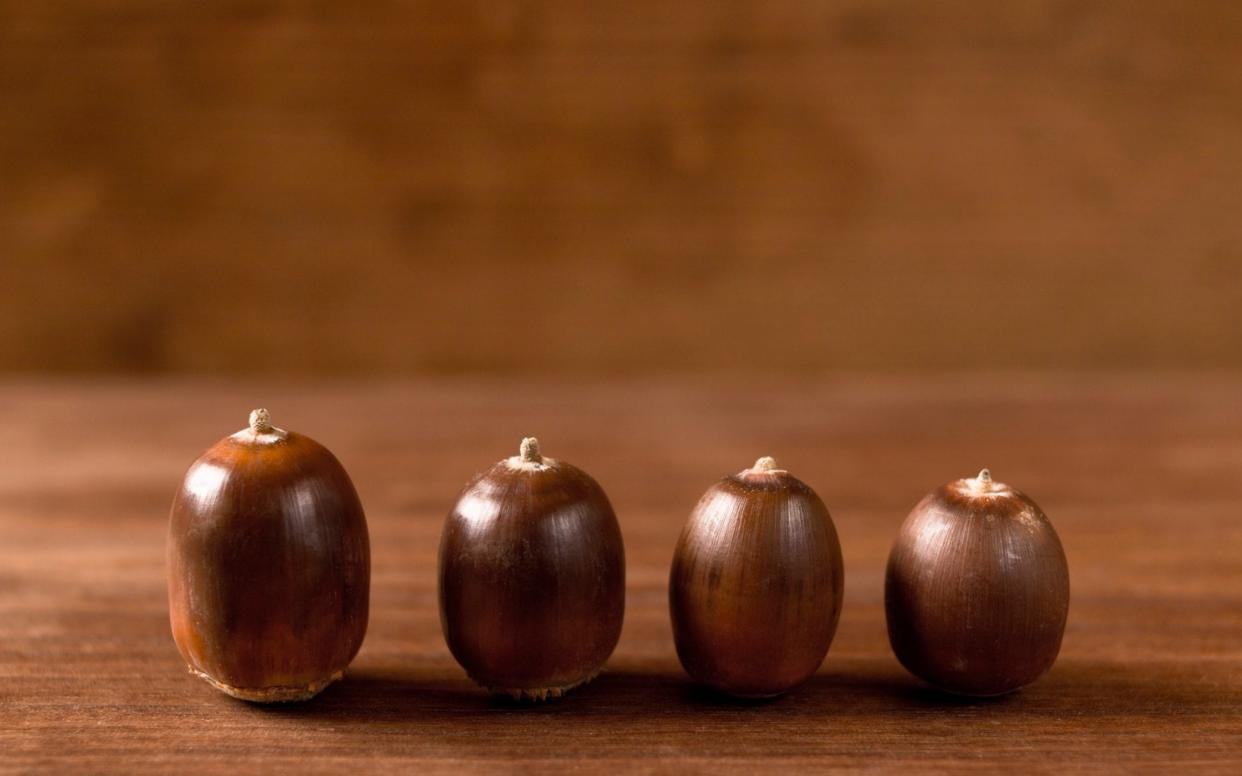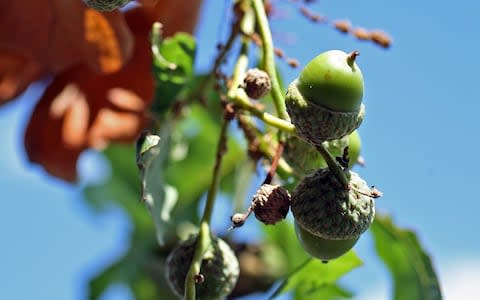Cancer-fighting, gut-boosting... how acorns became the new superfood

Mighty oaks, as the saying goes, grow from little acorns. So too, apparently, do weird trends. The squirrels of South Korea can testify, because they are being forced to compete for their winter staple, acorns, by an unusual rival: humans.
So greedy are the humans, apparently, that the squirrels are in danger of starving. According to the Wall Street Journal, the newly-formed Acorn Rangers of Seoul’s Yonsei University are now protecting the local oaks from would-be acorn-pickers. And those pickers may not be pigs, but they’re still greedy. A wildlife report from 2018 found that South Korea’s squirrel population had declined about 30 per cent in ten years.
The consequence of the media furore, unfortunately for the squirrels, is that ever more people across the world have become alerted to the nutritional value of acorns. At risk of angering the UK’s squirrel population, here’s a fairly eyebrow-raising example of the research that underpins the trend.
Earlier this year, a study published in the Journal of Nutritional Biochemistry showed that carbohydrate molecules isolated from acorns seemed to have promising effects on mice. The researchers, who work at the Wake Forest School of Medicine, North Carolina, reported that feeding the fibres to the mice seemed to improve the relationship between the creatures’ guts and brains, “and hence could be useful in preventing/treating diet-induced obesity and T2D”, meaning type 2 diabetes.

The (possible) benefits continued. As human and mouse gut microbiota digest these fibres, they produce the short-chain fatty acids that have, in other research, been linked to good heart health and lower rates of cancer.
Acorns, give or take the use of mice, not humans, and the thoroughly nascent state of this particular cranny of digestive science, are the scourge of obesity, the enemy of diabetes, the mortal foe of cancer. No wonder acorns have undergone the cultural equivalent of dashing into a phonebox and putting on a cape. They have gone from food to superfood.
But what do you do with them? Do you eat them raw? Do you get on your hands and knees and snuffle them up like a boar?
I ask Miles Irving, who is the author of the Forager Handbookand presents the WorldWide podcast. Irving, who supplies wild food to top UK restaurants, tells me that acorns “are a very nutritious food, and madly, they’re a food that goes to waste.”
He explains that acorns have a small amount of “quality oil”, “a good lot of protein and lots of polyphenols, which we don’t get enough of, and minerals.” Their good nutrition and their easy availability, Irving says, prompted pre-agricultural societies across the world to make them a staple of their diets. We started farming, and acorns became a food for lean times, then a food for pigs, and then barely a food at all, until the recent craze.
Irving doesn’t recommend eating them raw. They’re not poisonous, but “you’d probably have a sore tummy if you ate loads of them.”
Your discomfort would probably be caused by tannins, which are biomolecules that, apart from tasting astringent, bind themselves to nutrients and thus usher those nutrients out of the body without our getting their benefit. Acorns are high in tannins, but there are two ways of getting rid of them.
An easy way of doing that is roasting them. “You wouldn’t quite snack on it like you would peanuts,” Irving explains, because “it’s still a little bit astringent, there’s still some tannins there, but there’s a very rich, amazing flavour.”
Irving has had good results from chopping roasted acorns into bits and putting them in rice pudding with some raisins. They introduce “a sort of almost smokey flavour, almost toffee flavour.” He got the idea, he says, from the chef David Everitt-Mathias, who had learnt about acorn coffee – in which you roast acorns, grind them down, and make a hot drink out of them – and subsequently experimented with acorns in desserts.
The other way of getting the tannins out, Irving adds, is how it was traditionally done: leaching. This means that you use water to draw the tannins away. In times gone by, the acorns would have been shelled, then chopped or roughly ground, and put in a woven sack and submerged in a river, though today you could simply put your shelled, chopped acorns in a bowl of water or hot water if they are whole, leave them to settle for 12 hours, and repeat the process two or three times until the water is clear.
Dry them out, says Irving, and “you’ve got a meal or flour that you can use for baking.” He added some wheat flour to give the mixture some gluten, and made some pancakes. “They are amazing. More like a flatbread than a pancake, really. Quite a solid texture, but really delicious.”
You can buy acorns and acorn flour from various places online, such as Amazon and Etsy, or you can forage them from beneath oak trees in autumn. As for the South Koreans, they mash the acorns and boil the starch into a dense brown jelly, called dotori muk, that is served with soy sauce and scallions. You can even buy acorn noodles. In fact, taking Irving’s recipes into account, you could make a perfectly edible three-course meal with acorns. Think of the health benefits.
One of the most interesting elements of this is that oaks provide a very high yield of acorns – a yield that, per acre, compares well with grains, without depleting the soil of nutrients in the way that arable farming does. Perhaps acorns really could be a food of the future, provided we leave enough for the squirrels and enough for the oaks to keep reproducing. It might not be so nuts after all.
Two simple Woodland Trust recipes
Roasted acorns
For those who enjoy a savoury snack, salted nuts are the perfect choice. Roasting is probably the easiest way to cook acorns. They can be added to a winter stew for extra bite, too.
After hot water leaching, place the damp chunks onto a baking tray and sprinkle with salt.
Toast for 15-20 mins on a high heat.
When the colour starts to darken, they’re ready.
Cool and consume.

Acorn coffee
Acorn coffee is naturally caffeine free. It has a unique taste and is unlike traditional coffee, but it’s still delicious and warming.
Leach with hot water, then lay the acorns out in an ovenproof dish.
Roast on a low heat to dry slowly – this should take 1½ to 2 hours.
Move the acorns around the dish regularly to stop them catching.
The acorns will start to turn brown as they dry - you can choose whether you want a light or dark roast.
Once roasted to your preference, remove the acorns and cool.
Grind and enjoy.
For more information visit: woodlandtrust.co.uk

 Yahoo News
Yahoo News 
